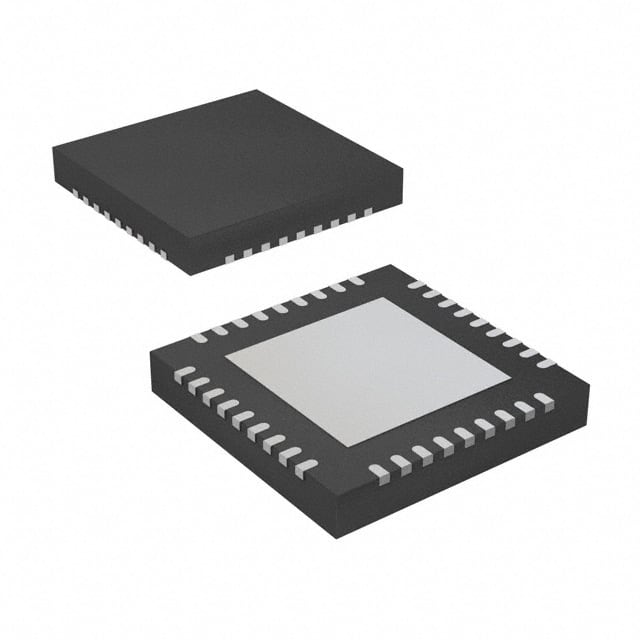PGA400QRHHRQ1
Basic Information Overview
- Category: Integrated Circuit (IC)
- Use: Signal Conditioning and Sensor Interface
- Characteristics: High Accuracy, Low Power Consumption
- Package: QFN (Quad Flat No-Lead)
- Essence: Analog Front-End for Sensor Applications
- Packaging/Quantity: Tape and Reel, 2500 units per reel
Specifications
- Supply Voltage Range: 2.7V to 5.5V
- Operating Temperature Range: -40°C to +125°C
- Input Offset Voltage: ±150µV (maximum)
- Gain Error: ±0.05% (maximum)
- Bandwidth: 500kHz (typical)
- Number of Channels: 4
Detailed Pin Configuration
The PGA400QRHHRQ1 has a total of 32 pins arranged as follows:
| Pin Number | Pin Name | Description | |------------|----------|-------------| | 1 | VDD | Positive Power Supply | | 2 | VSS | Ground | | 3 | IN1 | Input Channel 1 | | 4 | IN2 | Input Channel 2 | | ... | ... | ... | | 31 | OUT4 | Output Channel 4 | | 32 | REF | Reference Voltage Input |
Functional Features
- Programmable Gain Amplifier (PGA) with selectable gain options
- On-chip voltage reference for accurate measurements
- Built-in diagnostics for fault detection and protection
- Flexible input multiplexer for channel selection
- Low power consumption for battery-powered applications
Advantages and Disadvantages
Advantages: - High accuracy and precision in signal conditioning - Wide supply voltage range allows for versatile applications - Integrated diagnostics enhance system reliability - Small package size saves board space
Disadvantages: - Limited number of channels (4) - Relatively high cost compared to some alternatives - Requires external components for complete sensor interface
Working Principles
The PGA400QRHHRQ1 is designed to condition and amplify signals from various sensors. It consists of a programmable gain amplifier, input multiplexer, voltage reference, and diagnostics circuitry. The input signal is selected using the multiplexer and amplified by the PGA with a programmable gain setting. The amplified signal is then output through the corresponding channel. The on-chip diagnostics continuously monitor the system for faults and provide protection against overvoltage, undervoltage, and short circuits.
Detailed Application Field Plans
The PGA400QRHHRQ1 is widely used in applications that require accurate signal conditioning and sensor interface. Some common application fields include: - Industrial automation and control systems - Automotive electronics, such as engine management and vehicle diagnostics - Medical devices, including patient monitoring and diagnostic equipment - Energy management systems for renewable energy sources - Test and measurement instruments for precise data acquisition
Detailed and Complete Alternative Models
- AD8232: Integrated Signal Conditioning Front-End for Biopotential Measurements
- MCP6V01: Programmable Gain Amplifier with Low Input Offset Voltage
- INA125P: Precision Instrumentation Amplifier with High Common-Mode Rejection Ratio
- MAX4466: Low-Noise Microphone Preamplifier with Adjustable Gain
(Note: This list is not exhaustive and there are many other alternative models available in the market.)
This encyclopedia entry provides an overview of the PGA400QRHHRQ1 integrated circuit. It includes basic information, specifications, pin configuration, functional features, advantages and disadvantages, working principles, detailed application field plans, and alternative models. The PGA400QRHHRQ1 is a versatile IC used for signal conditioning and sensor interface in various industries.
Lista 10 Vanliga frågor och svar relaterade till tillämpningen av PGA400QRHHRQ1 i tekniska lösningar
Sure! Here are 10 common questions and answers related to the application of PGA400QRHHRQ1 in technical solutions:
1. What is PGA400QRHHRQ1? - PGA400QRHHRQ1 is a high-precision, programmable gain amplifier (PGA) designed for use in automotive and industrial applications.
2. What is the purpose of PGA400QRHHRQ1? - The purpose of PGA400QRHHRQ1 is to amplify low-level sensor signals accurately and reliably, enabling precise measurements in various technical solutions.
3. What are the key features of PGA400QRHHRQ1? - Some key features of PGA400QRHHRQ1 include high accuracy, programmable gain, low noise, wide bandwidth, and built-in diagnostics for fault detection.
4. What are the typical applications of PGA400QRHHRQ1? - PGA400QRHHRQ1 is commonly used in applications such as pressure sensing, temperature sensing, strain gauges, flow meters, and other sensor-based measurement systems.
5. How does PGA400QRHHRQ1 achieve high accuracy? - PGA400QRHHRQ1 achieves high accuracy through its low offset voltage, low offset drift, and low gain error, ensuring minimal signal distortion and precise amplification.
6. Can PGA400QRHHRQ1 be programmed for different gain levels? - Yes, PGA400QRHHRQ1 is programmable and can be configured for different gain levels using external resistors or digitally through its serial interface.
7. Does PGA400QRHHRQ1 have any built-in diagnostic features? - Yes, PGA400QRHHRQ1 has built-in diagnostics that enable fault detection and reporting, including open/short circuit detection and overvoltage/undervoltage detection.
8. What is the power supply requirement for PGA400QRHHRQ1? - PGA400QRHHRQ1 operates from a single power supply voltage ranging from 2.7V to 5.5V, making it suitable for a wide range of applications.
9. Is PGA400QRHHRQ1 suitable for automotive applications? - Yes, PGA400QRHHRQ1 is designed to meet the stringent requirements of automotive applications, including AEC-Q100 qualification and extended temperature range.
10. Are there any evaluation boards or reference designs available for PGA400QRHHRQ1? - Yes, Texas Instruments provides evaluation boards and reference designs for PGA400QRHHRQ1, which can help users quickly prototype and integrate the device into their technical solutions.
Please note that the answers provided here are general and may vary depending on specific application requirements.


